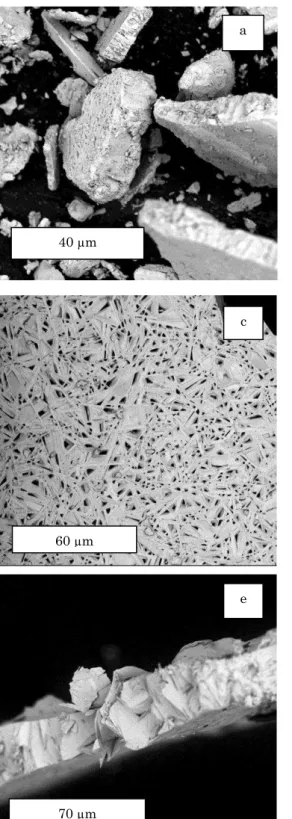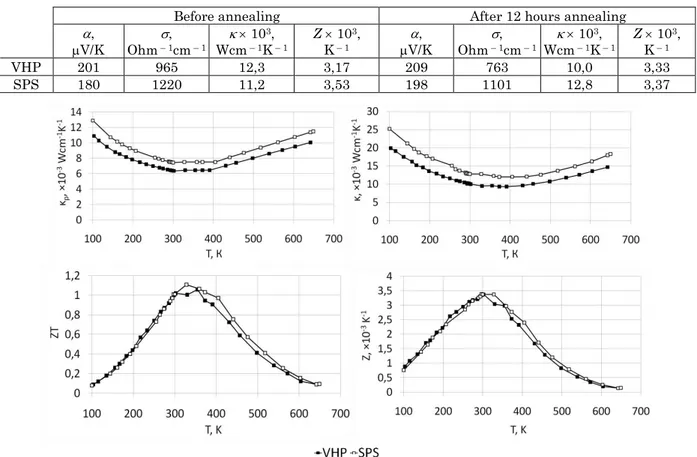JOURNAL OF NANO- AND ELECTRONIC PHYSICS Р А А - А Р
Vol. 6 No 3, 03061(4pp) (2014) Том6№ 3, 03061(4cc) (2014)
The article was reported at the International Conference «The Advanced Technology, Equipment and Analytical Systems for Materials», Kursk, 13-14 May, 2014
2077-6772/2014/6(3)03061(4) 03061-1 2014 Sumy State University
Structural, Dimensional and Thermoelectric Properties of Melt Spun p-Bi0,5Sb1,5Te3
A.A. Melnikov1,2,*, V.G. Kostishin1, S.A. Kichik2, V.V. Alenkov2
1National University of Science and Technology "MISIS", 4, Leninskiy Pr., 119049 Moscow, Russia 2Crystal Ltd, 45B, Stantsionnaya Str., 141060 Korolev, Moscow region, Russia
(Received 19 May 2014; revised manuscript received 03 July 2014; published online 15 July 2014)
Thermoelectric melt spun p-Bi0,5Sb1,5Te3 powders were obtained and their structural properties were studied. It was established that the crystallites constituting the powder particles are nanofragmented. Powders were compacted by vacuum hot pressing and spark plasma sintering. Thermoelectric characteris-tics of obtained samples were investigated in 100 K-700 K temperature range. The samples prepared by above methods posses low thermal conductivity while retaining values of the Seebeck coefficient and elec-trical conductivity comparable to conventional crystallized materials, thereby thermoelectric efficiency ZT reaches 1.05-1.15 at 330-350 K.
Keywords: Thermoelectricity, Melt spinning, Melt spun powders, Bismuth and antimony telluride, Spark plasma sintering.
PACS numbers: 72.15.Jf, 72.20.Pa
* kitmel@mail.ru
1. INTRODUCTION
Thermoelectricity has recently attracted an increas-ing interest as an alternative method of convertincreas-ing thermal energy into electrical energy and vice versa. Extension of applications area of thermoelectric mate-rials is associated with increasing its dimensionless thermoelectric figure of merit ZT, equal to
2 ZT T
(1)
where α– the Seebeck coefficient, V/K; – the electri-cal conductivity, Ohm– 1m– 1; κ– the thermal conduc-tivity, Wm– 1K– 1, T– the temperature of a material, K. Scientific researches aimed to increase the thermoe-lectric efficiency are associated with optimization of used materials and technologies (normal directed solid-ification, hot vacuum pressing, extrusion) and with a search for new materials (clathrates, skutterudites, nanomaterials) and technologies (melt spinning, spark plasma sintering).
The melt spinning is a promising technology of ob-taining materials, based on ultrafast cooling of melt and mainly used for preparation of amorphous alloys in metallurgy [1, 2]. The method is in serving of melt on a rotating water cooled wheel and crystallization of a material as thin films and powders. The cooling rate can reach 104-107 K/s [1], thereby structural properties and sizes of the crystallites should be different from a material crystallized in equilibrium conditions.
Preparation of thermoelectric materials by melt spinning technique was first described in [3, 4]. In works [5-8] materials with ZT values up to 1,5 were received. Recently, ZT values about 1,3 are confirmed by paper [9].
However, not enough attention to explanation of these results is paid. The main purposes of this work are preliminary structural analysis of the melt spun powders, test sintering by vacuum hot pressing (VHP)
and spark plasma sintering (SPS) and evaluation of properties of obtained materials.
2. DESCRIPTION OF OBJECTS AND METHODS
The melt spinning process was performed at the temperature of molten material of 650 °C. The wheel rotation speed was 1200 r/min, which resulted the crys-tallization rate of about 105-106 K/s. Evaluation of sur-face morphology, sizes and shapes of melt spun powders particles was conducted on the scanning electron micro-scope (SEM) FEI Phenom. The powders were compacted by VHP at 470 °C for 20 min and by SPS at 470 °C for 5 minutes under the same applied pressures. Stabilizing annealing of compacted samples was performed at 320 °C for 12 hours in vacuum.
Radiographic examinations of melt spun powders with different particles size as well as of compacted ma-terials were carried out using DRON-UM diffractome-ter, CuKα-radiation. The lattice parameters were deter-mined by Rietveld method for diffraction pattern with the smallest fraction of powder ( 40 microns) owing to most averaging. The coherent scattering regions (CSR) were determined by formula:
cos( ) k
d
(2)
where d– the average crystallite size, nm; – the wavelength of radiation used, (CuKα) 0,154051 nm;
– full width at half maximum, rad; θ– the diffraction angle, rad; k– the Scherrer constant 0,9.
A.A. MELNIKOV,V.G. KOSTISHIN, ET AL. J.NANO-ELECTRON.PHYS. 6, 03061 (2014)
03061-2
Fig. 1– SEM images of melt spun p-Bi0,5Sb1,5Te3 particles
component was determined as р –el, where the electron thermal conductivity component elAT, where A is the Lorenz number.
Thermoelectric efficiency of materials ZT was calcu-lated using formula (1).
3. RESULTS AND DISCUSSION
SEM images of melt spun Bi0,5Sb1,5Te3 particles are shown at Fig. 1. Most of the particles have the shape of
flat plates with size ranging from tens to hundreds of microns and thickness from ones to tens of microns; the smaller particles have a bulk form (Fig. 1a).
Flat sides of particles are parallel to cooled planes of the wheel. Their surface could be completely filled with material (Fig. 1d) or with presence of gaps between crystallites (Fig. 1b, c). Such a difference in forms of surfaces of same particles is explained with peculiarity of crystallization during the melt spinning process.
Af-b
180 µm a
40 µm
e
70 µm
d
20 µm
f
60 µm c
STRUCTURAL,DIMENSIONAL AND THERMOELECTRIC PROPERTIES… J.NANO-ELECTRON.PHYS. 6, 03061 (2014)
03061-3 ter a contact with the cooled wheel the melt begin to crystallize at each point of contact, forming a continu-ous surface, completely filled with the material. Then, due to the high crystallization speed and the growth anisotropy in bismuth and antimony chalcogenides the material crystallizes along predominant crystallograph-ic directions only, resulting submcrystallograph-icron crystallites in forms of plates or polygons with gaps between them observed on the surface (1b, c).
SEM images captured in a perpendicular direction (Fig. 1e,f) give an indication of the layered structure of melt spun particles. Particle consist of plural not strict-ly oriented crystallites in form of flakes with thickness ranging from tens of nanometers to several microns.
X-ray diffraction patterns of powders with different size are shown in Fig. 2. Notated size is the larger linear size of a particle. The 2θ-angles of main reflection peaks of the powders patterns correspond with peaks of Bi0,5Sb1,5Te3 crystallized under equilibrium conditions, what indicates the identity of the crystal structure; crystallographic group – R3m. A slight discrepancy in the intensities of peaks with ref-erence Bi0,5Sb1,5Te3 is associated with partial texturing during measurements, especially for powders with larger fractions. The identity of the crystal structure suggests that the flake-crystallites formed a powder particle are the sets of alternating monolayers of atoms –Te(1)–Bi,Sb–Te(2)–Bi,Sb–Te(1)–, as in crystallized under equilibrium conditions Bi0,5Sb1,5Te3 [10]. Exfoliations along cleavage planes, probably also mainly take place between adjacent layers of atoms Te(1) due to lowest binding energy. Thus, we can conclude that the struc-ture of melt spun particles differs from the strucstruc-ture of normally crystallized materials in orientations of crys-tallographic planes, surface morphology and dimen-sions and shapes of the crystallites.
Fig. 2– XRD patterns of melt spun p-Bi0,5Sb1,5Te3 powders with different size
Cell parameters of melt spun Bi0,5Sb1,5Te3 particles were determined by Rietveld method and amounted to: a 4,39592 Å, a 30,51287 Å.
CSD sizes of powders of different fractions are pre-sented in Table 1. Since the sizes of CSD are
estab-lished orders of tens of nanometers, there is an evi-dence of nanofragmentation of crystallites, presence of defects and twinning.
Table 1 – CSD sizes of melt spun p-Bi0,5Sb1,5Te3 particles
Particle size, m 40 40-94 94-315 315-500
СSD size, nm 37,4 44,7 40,2 51,6
Melt spun powders with size of 40-94 microns were compacted by VHP and SPS. Diffraction patterns of VHP samples taken from faces perpendicular and parallel to the pressure application axis are shown in Fig. 3. An increase in intensity of [110] reflection is observed in diffraction pattern taken from the side face parallel to the pressing axis, and increase in [003] reflection is observed in pattern taken from the end face perpendicular to the pressing axis. Thus, a partial axial texture [001] directed along the pressure axis is potentially able to be formed during the melt spun powders compacting, what can be related to laying texturing and an effect of deformation processes. A more detailed studying of texture formation during melt spun powders comacting is proposed for further researches.
Fig. 3– XRD patterns of melt spun p-Bi0,5Sb1,5Te3 compacted by VHP
Mechanical compressive strength of compacted melt spun material amounted 65 – 75 MPa, which is slightly above the average compressive strength of hot-pressed mechanically divided powders – 55-60 MPa [11]. These properties indicate applicability of the material for manu-facturing of thermoelements and microthermoelements for Peltier modules.
Thermoelectric characteristics at 27 °C of compacted melt spun powders before and after 12 hours annealing are represented in table 2. After annealing the thermoe-lectric efficiency Z increased for hot-pressed sample, but reduced for SPS sample, what can be explained by differ-ent structural and dimensional changes during the an-nealing process.
Temperature dependencies of thermoelectric char-acteristics of annealed samples in a direction perpen-dicular to the pressure axis are shown in Fig. 4. Ob-served values of thermal conductivity are of 10-30 % below
315 – 500 µm
315 – 500 µm
315 – 500 µm
315 – 500 µm
crystallized Bi0,5Sb1,5Te3
End face
Side face
A.A. MELNIKOV,V.G. KOSTISHIN, ET AL. J.NANO-ELECTRON.PHYS. 6, 03061 (2014)
03061-4
Table 1 – Thermoelectric characteristics of compacted melt spun Bi0,5Sb1,5Te3 at 27 °C
Before annealing After 12 hours annealing
, V/K
, Оhm– 1cm– 1
103, Wcm– 1K– 1
Z 103, K– 1
, V/K
, Оhm– 1cm– 1
103, Wcm– 1K– 1
Z 103, K– 1
VHP 201 965 12,3 3,17 209 763 10,0 3,33
SPS 180 1220 11,2 3,53 198 1101 12,8 3,37
Fig. 4– Temperature dependences of thermoelectric characteristics of compacted melt spun p-Bi0,5Sb1,5Te3
values of thermal conductivity are of 10-30 % below
average for crystallized materials owing to a scattering
of thermal phonons on grain boundaries due to struc-tural features of the melt spun powders. The Seebeck coefficient and the conductivity values of investigated samples and crystallized materials roughly correspond.
Due to this, the ZT parameter of compacted melt spun
materials reach values of 1,05-1,15 in 330-350 K area.
4. SUMMARY
Structural and dimensional characteristics of p-Bi0,5Sb1,5Te3 powders prepared by melt spinning tech-nique are studied. The crystallographic group and the lattice parameters are identical to material crystallized in equilibrium conditions. Key features enhancing thermoelectric characteristics in melt spun powders
apparently are dimensions and shape of the crystal-lites, their orientation and the surface morphology.
The coherent scattering regions were defined as tens of nanometers, what suggests, that the melt spun p-Bi0,5Sb1,5Te3 crystallites are nanofragmented.
It was found that the partial axial texture [001] di-rected along the axis of pressure application could be formed during the powders compacting.
Temperature dependences of thermoelectric charac-teristics of the material compacted by vacuum hot pressing and spark plasma sintering were measured in direction perpendicular to the pressure application ax-is. It is demonstrated that the compacted samples pos-ses low thermal conductivity, thereby ZT amount reach 1,05-1,15 in 330-350 K area.
REFERENCES
1. Physical Metallurgy (Ed. by R.W. Cahn) (Amsterdam: Elsevier Science Publishers B.V.: 1996).
2. A.F. Belov, V.M. Glazov, Yu.V. Yatmanov, A.Ya. Potemkin,
DAN SSSR277, 1155 (1984) [in Russian].
3. V.M. Glazov, Yu.V. Yatmanov, A.B. Ivanova, Izv. AN SSSR. Neorganicheskiye materialy22, 596 (1986) [in Russian]. 4. O.Sh. Gogishvili, S.P. Lalykin, S.P. Krivoruchko,
K.I. Puruchidi, E.S. Tsanava, VII Vsesoyuz. konf.
“Khi-miya, fizika i tekhnicheskoye primeneniye khal'kogenidov, 367 (Uzhgorod: 1988) [in Russian].
5. W.J. Xie, X.F. Tang, G. Chen, Q. Jin, Q.J. Zhang, 26th Interna-tional Conference on Thermoelectrics, 23 (Jeju: IEEE: 2007). 6. W. Xie, X. Tang, Y. Yan, Q. Zhang, T. Tritt, Appl. Phys.
Lett. 94, 102111 (2009).
7. W. Xie, X. Tang, Y. Yan, Q. Zhang, T. Tritt, J. Appl. Phys.
105, 113713 (2009).
8. W. Xie, J. He, H.J. Kang, X. Tang, S. Zhu, Nano Lett. 10, 3283 (2010).
9. L.D. Ivanova, L.I. Petrova, Yu.V. Granatkina, Termoel-ektrichestvo2013 No 1, 34 (2013).
10.B.M. Gol'tsman, V.A. Kudinov, I.A. Smirnov, Poluprovod-nikovyye termoelektricheskiye materialy na osnove Bi2Te3
(Moskva: Nauka: 1972) [in Russian].


